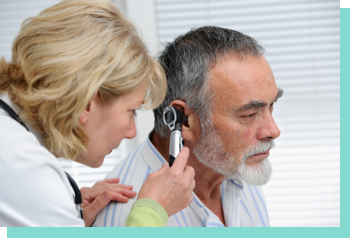Tinnitus is largely self-reported and subjective in nature. There is no standard definition of tinnitus but it is generally considered to be the perception of sound where there is no audible source. This “phantom” sound can be heard in one or both ears.
Patients are generally considered to have tinnitus if they hear these noises chronically with some studies defining it as 3 or more months1, while guidelines define tinnitus as 6 months or more of persistent symptoms.2 Tinnitus is not itself a disease but may be a symptom of other medical conditions.


Ringing in the ears may be temporary or permanent and estimates are that over 50 million people suffer from tinnitus in the United States.
Previously, guidelines from the American Academy of Otolaryngology-Head and Neck Surgery recommended against the use of supplements for tinnitus. Despite this, the use of dietary supplements is very common to help patients with ringing in the ears and some patients have reported a reduction in their symptoms.
A newly published supplemental guideline advisory provides one view on which supplements may or may not be appropriate in management of tinnitus, and the situations in which it may be appropriate to undertake a trial of supplements.
Currently there are no prescription medications approved by the FDA for treatment of tinnitus. With this in mind it is necessary to create a comprehensive list of best practices and recommendations for supplement trial in tinnitus patients.
Supplements with Recommendations from Guideline Advisory
| Supplement | Mechanism of Action | Side Effects | Recommended Dose | Trial May Be Appropriate |
| Bioflavonoids | Possible circulation improvement | Minimal (allergies, upset stomach) | 2 capsules TID at onset for 60 days, then 1 capsule TID for maintenance | Yes |
| Ginkgo biloba (EGb761) | Vasoregulatory antioxiden suppression of platelet activating factor change in neuron metabolism | GI side effects, bleeding, seizures, headache/dizziness, nausea | 120-160 mg to start up to 240 mg BID | Yes |
| Magnesium | Possible improved microcirculation reduced oxidative stress | Diarrhea, headache, sleep, disturbance | 532 mg daily shown to be effective in one study | No |
| Melatonin | Sleep | Increased urination, headache, dizziness | 3 mg nightly | Yes |
| Vitamin B1, B3, B6 | Effects on CSN and higher cognitive function | Bleeding, sleep disturbance, GI upset | N / A | No |
| Vitamin B12 | Deficiency noted in patients with tinnitus | Headache, dizziness, blurred vision, GI upset | >2500 mcg intramuscular / week | Sometimes |
| Zinc | Zinc present in inner ear | Zinc toxicity, copper deficiency | N / A | No |
BID, twice per day; mg, milligram; TID, three times per day
* None of the above supplements have a completely confirmed mechanism of action.
Appropriate Patients and Best Practices for Trying Supplements
When it may be appropriate to try a supplement
- Ensure proper medical and audiological evaluation.
- Explore counseling, hearing aids, and sound therapy prior.
- Understand the goal of management is to help manage reactions and symptoms, including sleep and mood, and improve overall quality of life.
- Understand supplements are not likely to help all patients.
- Ensure you know what is in the supplement.
- Clear understanding of the costs and trial period (e.g. some supplements provide a money-back guarantee).
- Identify all reasonably possible side effects ahead of time based on the type of supplement you decide to start with and identify recommended restrictions while taking supplement.
Have a plan for performing a “controlled trial”, as it is important to have a baseline approach. If you are going to try supplements, you should keep all common factors as constant/status quo as possible.
Examples of Common Factors:
- Diet
- Caffeine intake
- Alcohol intake
- Prescription medications
- Other medications and supplements
- Sleep schedule
Overview of Management Strategies
- There is no cure for tinnitus, and current treatment strategies focus on managing reactions to symptoms of tinnitus.
- Outside of the supplements covered in this advisory, some of the common management strategies include hearing aids, sound therapy, and counseling, such as tinnitus retraining therapy and tinnitus activities treatment.
- The success of these treatments to help patients with their reactions to their tinnitus varies widely from one individual to another.
- As a rule of thumb, you should utilize less invasive treatment options followed by more invasive strategies if initial treatment fails and the tinnitus is severe.
- Individualization is key in managing tinnitus symptoms. Every patient is different, and what works for some may not work for others.
- Treatment will need to be individualized to the patient taking into account the phase of tinnitus (acute vs. chronic), level of the lesion (peripheral or central) and the type of distress (anxiety, hearing, sleep and/or concentration).
- Management strategies require a multipronged approach with a combination of hearing aids, sound therapies and counseling
- Future treatments might include neuromodulation [direct (DBS, DCS) or indirect (VNS, somatic stimulation)], prescribed drugs or cochlear implants.

Review of the tinnitus prevalence and demographics of the most typical patients presenting with tinnitus
Tinnitus is not uncommon, particularly among older adults. Because there is no agreed upon definition, it is difficult to accurately estimate the number of tinnitus sufferers. Incidence, or the risk of developing the condition over time, is 12.7% cumulatively over 10 years.3 Adding to the complexity of describing this condition, tinnitus can improve spontaneously and severity may fluctuate as patients develop a tolerance to the symptoms.2 Prevalence for tinnitus is estimated at 25.3%. A 1996 National Health Interview Survey estimated that 35-50 million adults have tinnitus, with 12 million seeking medical help and 2-3 million experiencing severely debilitating symptoms.1 Non-Hispanics are more likely to report having tinnitus than Hispanics and non-Hispanic blacks. These distinctions between race and ethnicity suggests that tinnitus may be caused by something independent of hearing impairment.4 IMS medical claims data in full year 2015, showed that 369,220 patients were treated for tinnitus, with 20% of the total newly diagnosed. Patients aged 55-64 represented 27% of patients, while patients aged 65+ represented 36% of the total, further evidence that prevalence of tinnitus increases with age. Tinnitus is often associated with some level of hearing loss although 13 million people with tinnitus reported no loss.5 Historically, males were more likely to have tinnitus than females because there was a strong correlation with exposure to occupational noise. Because males were affected at a statistically higher rate, it was often attributed to their greater exposure to environmental noise1 in occupations such as the military, construction or musicians. IMS medical claims data from 2015, however, show that 55% of patients treated for tinnitus were female and 45% were male. And, newly diagnosed females accounted for 57% of the total, with males just 43%.6 It will be important to monitor prevalence of tinnitus by gender over time to see if this trend continues.

- MEN have had higher rates of tinnitus, however, in 2015, more WOMEN were treated and newly diagnosed.
- AGE RELATED, increasing around 40 years old, peaking at 65-79 years old, declining after 80 years
- Almost 40% of tinnitus suffers experience it 80% OF THEIR DAY
- 1 IN 4 report their tinnitus as loud
- 1 IN 5 report their tinnitus is disabling or nearly disabling
- NON-HISPANIC BLACKS AND HISPANICS had a lower prevalence than non-hispanic whites
Source: Kochkin 2011; NIDCD 2012;
Nondahl 2010; IMS 2015 medical claims data

Patient Identification
Physical examination and patient history are essential in making a differential diagnosis due to the subjective nature of tinnitus. Distinguishing subjective from objective tinnitus and identifying underlying disease is essential to developing a treatment plan. Patient evaluation begins with a thorough history to determine symptom onset, location, and possible causes (environmental or medical). If a medical cause is suggested, laboratory tests are indicated (thyroid studies, complete blood chemistry, lipid levels, etc). Patients reporting tinnitus should undergo audiometric assessment including diagnostic testing such as a baseline audiogram, speech discrimination testing, and tympanometry. Additional audiologic measures may be needed to determine appropriate therapy. An otologic exam should also be performed to determine cerumen impaction, perforation, infection, cranial nerve damage or vascular involvement.7 Treating an underlying condition may improve tinnitus. Cerumen impaction or other obstructions can be relieved and infection can be treated.2 It is important to find mechanisms to improve quality of life for as long as tinnitus is an issue.
SELECTED RISK FACTORS
(ASSOCIATED WITH DEVELOPING TINNITUS):
- Head trauma or neurologic disorders (5-10%)
- Otologic (ex., Meniere’s)
- Arthritis
- Metabolic abnormalities (ex., hyperlipidemia, hyperthyroidism)
- Ototoxic drugs (antibiotics such as gentamicin, analgesics such as aspirin and ibuprofen)
- Long term noise exposure
Source: Tunkel 2014; Nondahl 2010; Bauman 2013
Impact of tinnitus – other comorbid conditions
Tinnitus is recognized as debilitating, affecting a patient’s overall health status and quality of life. Tinnitus patients are at risk for anxiety and depression, with 48 – 60% of tinnitus patients reporting depression.2 It is linked to a variety of risk factors including co-morbid conditions such as autoimmune disease, hypertension, diabetes, dyslipidemia and arthritis.3 There are over 550 drugs that are known to be ototoxic, some causing transient and reversible tinnitus and others resulting in permanent damage.8 Current and past smokers may have a higher likelihood of tinnitus but this is not universally agreed upon. Patients with a higher body mass index (BMI _ 30 kg/m2) are also believed to be at greater risk.2 Tinnitus patients have problems with social interactions and other lifestyle issues. They often experience difficulty with work and bouts of insomnia.4 The impact of tinnitus is considerable because it affects hearing, concentration and sleep, as well as other social activities. Tinnitus is a serious economic burden in the U.S. Not only does it negatively impact workplace productivity, it is a major source of disability and health care costs. Among U.S. veterans, disability payments related to tinnitus have increased 16.5% annually. It is estimated that 1.5 million U.S. veterans will receive disability compensation by 2016 at a cost to taxpayers of more than $2.75 billion.2
More than half (55%) of patients reporting tinnitus experienced some negative effect on quality of life.
REFERENCES
- NIDCD Health Information. Prevalence of Chronic Tinnitus. 19094-1995 National Health Interview Study Disability Supplement 2012, Accessed May 2015 www.nidcd.nih.gov/health/statistics/Pages/prevalence.aspx
- Tunkel, DE etal. Clinical Practice Guideline: Tinnitus. Otolaryngology: Head and Neck Surgery. 2014; 151(2S) S1-40.
- Nondahl DM, et al. The 10-Year Incidence of Tinnitus Among Older Adults. Int J Audiol 2010, 49(8):580-585.
- Shargorodsky J, Curhan GC, Farwell WR. Prevalence and Characteristics of Tinnitus Among US Adults. Am J of Med Aug 2010; 123(8).
- Kochkin S, Tyler R, Born R. MarkeTrak VIII: The Prevalence of Tinnitus in the United States and the Self-Reported Efficacy of Various Treatments. www.hearingreview.com, Nov 2011, Accessed May 2015. www.betterhearing.org/sites/default/files/hearingpedia-resources/MarkeTrak%20VIII%20Prevalence%20of%20Tinnitus%20and%20Efficacy%20of%20Treatments.pdf
- IMS Medical Claims Data, Jan-Dec, 2015.
- Crummer RW, Hassan GA. Diagnostic Approach to Tinnitus. Am Fam Physician. 2004 Jan 1;69(1):120-6
- Bauman NG. Prescription Medications, Over-The-Counter Drugs, Herbs and Chemicals Associated with Tinnitus. Downloaded www.hearinglosshelp.com. 2013 Edition.
